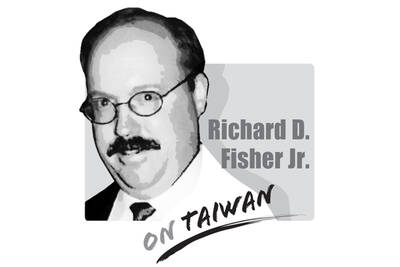China’s expansionist policies since Chinese President Xi Jinping (習近平) came to power — which include the Chinese Communist Party’s (CCP) efforts to reformulate the world order in its own image, as well as its “united front” tactics targeting educational and political institutions, industry and cyberspace — are increasingly setting off alarm bells in governments around the world.
As other nations are waking up to the threat posed by the CCP’s hegemonic intentions, Taiwan’s experiences and positioning are seen in greater relief.
The nation’s experience of China’s bullying and suppression, its value as an Asian democracy, the strategic geopolitical importance of its location within the first island chain and the US’ guarantees of protection are being given new importance.
In a news release on Monday last week introducing the bipartisan Taiwan Allies International Protection and Enhancement Initiative (TAIPEI) Act, US Senator Bob Menendez was quoted as saying that China is continuing “its quest for dominance through predatory diplomatic and economic practices.”
He also said that the bill would serve “as a recommitment by the United States Congress to a comprehensive, durable and mutually beneficial US-Taiwan relationship and partnership,” as well as an “affirmation of Taiwan’s place in the international community.”
The bill, introduced by Menendez and fellow senators Cory Gardner, Marco Rubio and Ed Markey, is a response to the severing of diplomatic ties by the Gambia, El Salvador, Sao Tome and Principe, Panama, the Dominican Republic and Burkina Faso in favor of ties with Beijing since President Tsai Ing-wen (蔡英文) was elected in 2016 “due to Chinese pressure and bullying tactics,” the news release said.
Rubio spoke of China’s “insidious agenda to isolate Taiwan,” which he said “cannot go unanswered.”
The opening lines of the bill say that the 1979 Taiwan Relations Act (TRA) stipulates that it is US policy to maintain the ability to “resist any resort to force or other forms of coercion that would jeopardize the security, or the social or economic system, of the people on Taiwan.”
This is undeniably what the CCP is doing, and has been doing for decades.
The bill also says that the CCP has intensified its efforts to pressure Taiwan since Tsai’s election, and that Tsai believes the severance of ties is “part of a series of diplomatic and military acts of coercion.”
Whether the bill passes, its legislative intent — to strengthen Taiwan’s standing in the world by having the US monitor the CCP’s efforts to induce Taiwan’s diplomatic allies to switch ties, and to use the US’ diplomatic and foreign aid to prevent this from happening — signals a level of awareness and urgency in Washington that is welcome to Taiwan.
The bill’s wording is also welcome. Reaffirming the US’ responsibilities in the TRA, recognizing that the CCP’s efforts at coercion are real and intensifying, reacknowledging the value of Taiwan’s democratic and open society, and promising to improve Taiwan’s international engagement are all important words from a crucial ally.
Despite Washington’s adherence to its “one China” policy, the wheels of policymaking and the renewed wariness of the CCP’s ambitions under the current US administration are slowly inching things in Taiwan’s favor.
The narrative surrounding Indian Prime Minister Narendra Modi’s attendance at last week’s Shanghai Cooperation Organization (SCO) summit — where he held hands with Russian President Vladimir Putin and chatted amiably with Chinese President Xi Jinping (習近平) — was widely framed as a signal of Modi distancing himself from the US and edging closer to regional autocrats. It was depicted as Modi reacting to the levying of high US tariffs, burying the hatchet over border disputes with China, and heralding less engagement with the Quadrilateral Security dialogue (Quad) composed of the US, India, Japan and Australia. With Modi in China for the
The Jamestown Foundation last week published an article exposing Beijing’s oil rigs and other potential dual-use platforms in waters near Pratas Island (Dongsha Island, 東沙島). China’s activities there resembled what they did in the East China Sea, inside the exclusive economic zones of Japan and South Korea, as well as with other South China Sea claimants. However, the most surprising element of the report was that the authors’ government contacts and Jamestown’s own evinced little awareness of China’s activities. That Beijing’s testing of Taiwanese (and its allies) situational awareness seemingly went unnoticed strongly suggests the need for more intelligence. Taiwan’s naval

On Sept. 3 in Tiananmen Square, the Chinese Communist Party (CCP) and the People’s Liberation Army (PLA) rolled out a parade of new weapons in PLA service that threaten Taiwan — some of that Taiwan is addressing with added and new military investments and some of which it cannot, having to rely on the initiative of allies like the United States. The CCP’s goal of replacing US leadership on the global stage was advanced by the military parade, but also by China hosting in Tianjin an August 31-Sept. 1 summit of the Shanghai Cooperation Organization (SCO), which since 2001 has specialized
A large part of the discourse about Taiwan as a sovereign, independent nation has centered on conventions of international law and international agreements between outside powers — such as between the US, UK, Russia, the Republic of China (ROC) and Japan at the end of World War II, and between the US and the People’s Republic of China (PRC) since recognition of the PRC as the sole representative of China at the UN. Internationally, the narrative on the PRC and Taiwan has changed considerably since the days of the first term of former president Chen Shui-bian (陳水扁) of the Democratic